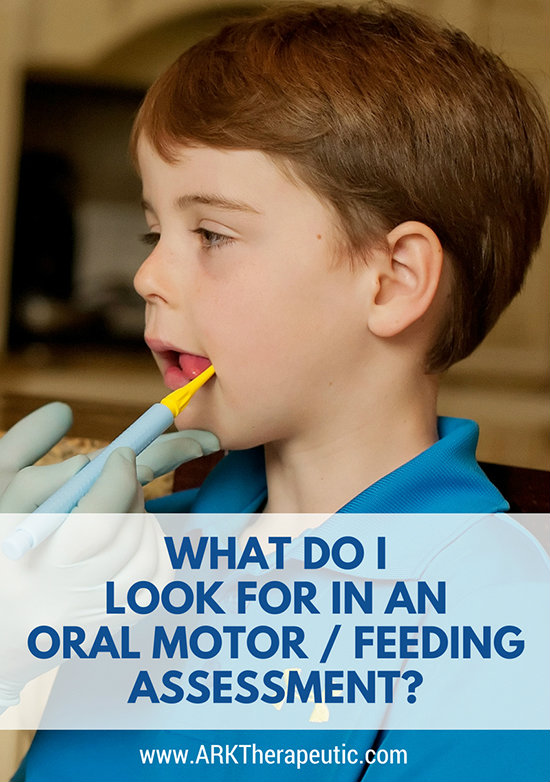What Do I Look for in an Oral Motor / Feeding Assessment?
Posted by Debra C. Lowsky, MS, CCC-SLP on 15th Jun 2018
What do I look for when I’m doing an oral motor / feeding assessment? It's never a cookie-cutter check list. It always depends on the individual and their skills and goals and where the evaluation, medical history, family history, etc. lead me. But, there are some general skills that I look for and “tests" that I do:
Is there tongue lateralization? Is the tongue moving from side to side, or is it just pumping up and down?
Is there tongue elevation ( tongue tip, mid-blade, and back of tongue)?
Is there lip closure?
How is the individual manipulating food? Is there rotary chewing? The tongue should be moving food from side to side before forming it into a bolus (ball of food). The bolus should then be positioned between the palate and the middle of the tongue, and then passed to the back of the tongue, triggering an automatic swallow?
How many times does the individual chew a bite of food? This will vary a lot depending on the kind of food. For example, a banana slice will be a lot easier to chew and will require fewer chews than a piece of carrot. I’ll try the food myself to see how many it should take - that’s really key. Personally, I sometimes have to chew things up to 20-30 times, which takes strength and endurance.
.

.
When the individual is chewing, I’ll feel the masseter bulge and the temporalis to see if they’re working.
Is there oral tone? Drooping, drooling, the tongue positioned low and forward, open mouth posture, flaccid not toned cheeks, food loss, etc. may be signs of low oral tone.
Is the individual swallowing everything? After the individual swallows, I’ll ask him/her to open the mouth so I can see if there are food particles left on the tongue and/or scattered throughout the oral cavity. Can the individual do a lingual sweep to collect any leftover food particles? Is there awareness of food left on the lip, tongue, cheek, palate, or gum area? Does he/she swallow on their own, or do they need to be cued/prompted to swallow?
How is the oral resting posture? The tongue should be not be making contact with either the bottom or top teeth, but retracted inside the oral cavity with the tongue tip resting on the alveolar ridge. The jaw should be maintained in a high but not completely closed (upper and lower teeth almost touching each other, but not touching).
I’ll watch the individual drink from a straw, looking for lip closure, lip tension, cheek tension, tongue retraction, spillage, etc. I’ll also check the length of the straw to make sure they’re not putting too much of the straw inside the mouth. You can see how I do this at about 1:11 into the video below - As he takes a sip, I put my fingers where the straw meets the lips, then remove the straw to see how much of the straw he had in his mouth. Using a Lip Blok can help here. Ideally I only want 1/4" of the straw inside the mouth (click here to learn why).
.
.
Is there a tongue thrust? One thing I’ll have the individual take a small sip of water and hold it in his/her mouth. Very lightly I’ll rest my hand under the chin, tell the individual to swallow, and “follow the swallow” with my hand. If my hand moves forward during the swallow, this is one of several indications that there may be a tongue thrust. The hand should not move.
As the individual drinks, I’ll also listen for gulping and gurgling sounds, which could mean there's too much air in the swallow, and/or that the swallow isn’t coordinated.
Check the food diary - I’ll have the parents keep a food diary to gather more information. Everything the child eats for three days, including notes on how easy or hard it was for him/her to eat each food.
I’ll also check the individual’s medical history, especially GI - everything must be ruled out and/or addressed first - ENT, GI, esophagus, swallow study, MBSS, FEES, etc.
I’ll look at the parent’s history, too. The parents might have a tongue thrust too for example. Or the parents might dislike certain foods and may have passed those preferences on to their kids (my own kids won’t go near mushrooms because of me for example - I think they’re gross). And so forth.
Are there any signs of sensory issues / aversions? I’ll watch facial expressions and body language. Grimacing, gagging, pulling away, turning the head - those are the easy/obvious ones. I also look at facial expressions and read the eyes as well, looking for signs of dislike, fear, concern, like, delight, etc., especially if the individual is nonverbal.
This list is by no means all-inclusive, but I hope you find it helpful!
To any parents reading this - If you are at all concerned about your child's oral motor / feeding skills, please do consult with a feeding therapist so they can assess things in person, put together a personalized treatment plan if needed, and guide you through it.
Debbie
Debra C. Lowsky, MS, CCC-SLP
.

